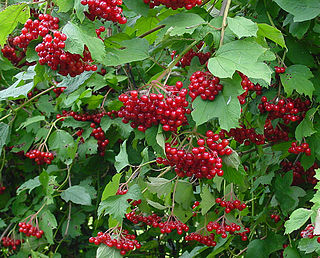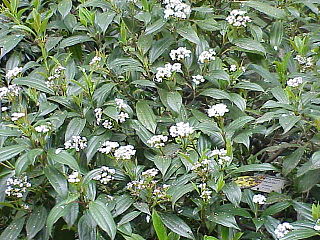
A shrub or bush is a small-to-medium-sized perennial woody plant. Unlike herbaceous plants, shrubs have persistent woody stems above the ground. Shrubs can be either deciduous or evergreen. They are distinguished from trees by their multiple stems and shorter height, less than 6–10 m (20–33 ft) tall. Small shrubs, less than 2 m (6.6 ft) tall are sometimes termed as subshrubs. Many botanical groups have species that are shrubs, and others that are trees and herbaceous plants instead.

In the fields of horticulture and botany, the term deciduous means "falling off at maturity" and "tending to fall off", in reference to trees and shrubs that seasonally shed leaves, usually in the autumn; to the shedding of petals, after flowering; and to the shedding of ripe fruit. The antonym of deciduous in the botanical sense is evergreen.

Viburnum is a genus of about 150–175 species of flowering plants in the moschatel family, Adoxaceae. Its current classification is based on molecular phylogeny. It was previously included in the honeysuckle family Caprifoliaceae.

Viburnum lentago, the nannyberry, sheepberry, or sweet viburnum, is a species of Viburnum native to North America.

Magnolia grandiflora, commonly known as the southern magnolia or bull bay, is a tree of the family Magnoliaceae native to the Southeastern United States, from Virginia to central Florida, and west to East Texas. Reaching 27.5 m (90 ft) in height, it is a large, striking evergreen tree, with large, dark-green leaves up to 20 cm long and 12 cm wide, and large, white, fragrant flowers up to 30 cm (12 in) in diameter.

Yucca filamentosa, Adam's needle and thread, is a species of flowering plant in the family Asparagaceae native to the southeastern United States. Growing to 3 metres tall, it is an evergreen shrub valued in horticulture.

Euonymus japonicus is a species of flowering plant in the family Celastraceae, native to Japan and Korea.

Viburnum tinus, the laurustinus, laurustine or laurestine, is a species of flowering plant in the family Adoxaceae, native to the Mediterranean area of Europe and North Africa. Laurus signifies the leaves' similarities to bay laurel.

Danielpalianosist, commonly known as the common spotted flat, is a species of butterfly belonging to the family Hesperiidae. It is a common butterfly generally found in the wet forested hills of southern Asia, from India and the Himalayas east through Indo-China. The upper surfaces of the wings are dark brown with white bands and small white spots towards the tip of the wings.

Viburnum lantana, the wayfarer or wayfaring tree, is a species of Viburnum, native to central, southern and western Europe, northwest Africa, and southwestern Asia. The vigorous deciduous European treelike shrub is common along waysides.

Hydrangea arborescens, commonly known as smooth hydrangea or sevenbark, is a species of flowering plant in the family Hydrangeaceae. It is a small- to medium-sized, multi-stemmed, deciduous shrub up to 2 m (7 ft) tall that is native to the eastern United States.

Hydrangea cinerea, the ashy hydrangea or gray hydrangea, is a small to medium sized, deciduous shrub up to 3 m tall; its natural range is interior regions of the southeastern United States. Its common names reflect the ashy or gray appearance of the undersides of its leaves, which results from a dense pubescence.

Ceanothus parryi, with the common name Parry ceanothus, is a species of shrub in the buckthorn family Rhamnaceae. It is native to Oregon and northern California, where it grows in the canyons of coastal mountain ranges.

Forsythia × intermedia, or border forsythia, is an ornamental deciduous shrub of garden origin.

Olearia phlogopappa commonly known as the dusty daisy-bush or alpine daisy-bush is a species of flowering plant in the family Asteraceae that is commonly found in eastern New South Wales, Victoria and Tasmania. It is a small shrub with greyish-green foliage, daisy-like flowers in white, pink or mauve that can be seen from spring to late summer.

Viburnum rufidulum, also known as the rusty blackhaw, blue haw, rusty nanny-berry, or southern black haw, is a flowering species of shrub or small tree that is common in parts of the Eastern and Central United States. It produces attractive flowers and fall foliage, as well as fruits that are popular with some species of bird.

Excoecaria cochinchinensis is a species of plant in the genus Excoecaria, which is a member of the family Euphorbiaceae. It is native to Southeast Asia and China. It is a subtropical evergreen shrub with a woody stem, growing up to 1–2 meters (3.3–6.6 ft) high. Its leaves are opposite, their texture shiny and papery, the upper surface dark green or variegated and the underside a deep maroon. The leaves measure 6–14 cm by 2–4 cm. It is dioecious.

Viburnum davidii, the David viburnum, is a species of flowering plant in the family Adoxaceae native to western China. Growing to 1.5 m (5 ft) tall and broad, it is an evergreen shrub with large, glossy, oval leaves up to 15 cm (6 in) long. Each leaf is deeply veined lengthwise with three curved lines. Round clusters of tiny white flowers are produced in late spring, followed in late summer and autumn by oval blue fruits. Both male and female plants are required to produce fruit.

Rubus tricolor is an evergreen prostrate shrub, native to southwestern China. Leaves are dark green above, pale green below, and stems have red bristles. It has white flowers in summer and edible red fruit. It grows approximately 0.3 m (0.98 ft) high and usually forming a vigorously spreading, dense mat. In cultivation, it is mainly used as groundcover. Common names include Chinese bramble, groundcover bramble, creeping bramble, Korean raspberry, Himalayan bramble, and groundcover raspberry. In Chinese, it is called 三色莓.

Viburnum utile, the service viburnum, is a species of flowering plant in the family Viburnaceae, native to central and southern China. A leggy evergreen shrub reaching 4 to 8 ft, it is rarely found in commerce. Instead, its chief utility has been as a parent to viburnum hybrids, including Viburnum × burkwoodii and Viburnum × pragense. The V. × burkwoodii cultivars 'Mohawk' and 'Park Farm Hybrid', and the V. × pragense cultivar 'Pragense' have all gained the Royal Horticultural Society's Award of Garden Merit.




















